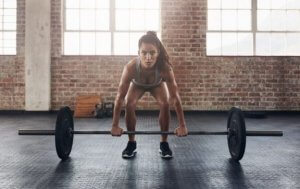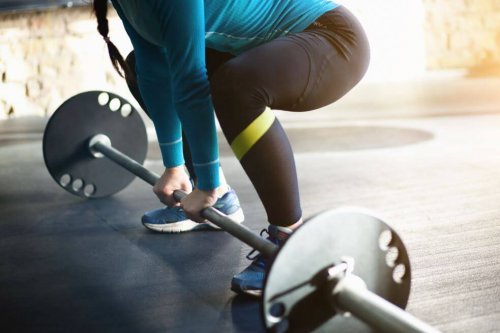Deadlift Techniques: train effectively

Whether you want to burn fat, improve your physical condition or simply gain strength, the deadlift technique trains your body effectively and is one of the most complete exercises.
It’s essential to perform this type of routine in the correct way. A good technique reduces the risk of injury. Although the risk isn’t entirely eliminated, having good physical condition distributes the stress of the lifting. It’s important to avoid placing an excessive load in a specific area.
Benefits of the deadlift
Deadweight lifting exercises provide us with some important benefits:
- The deadlift technique helps build muscle mass and also helps burn fat, even in a resting state.
- Strengthens and works muscle groups: lower back and hamstrings area, upper back and arms, trapezius, erector muscles of the spine, and the hips.
- Tones the glutes, gastrocnemius, and quadriceps.
- Corrects and improves body posture.
- Stimulates the motivation to achieve as it challenges the athlete with greater weight and difficulty.
- You can practice it at home or in the gym with similar effectiveness in muscle work.

The different phases
We can divide this exercise routine into several stages:
- Initial phase: this is considered the most important. Executing this phase correctly will guarantee the success of the entire exercise. The best technique is one that allows you to lift a lot of weight with the least possible effort.
- Mid phase or moment of inertia: it starts from when the force is generated until the shoulders are positioned behind the bar.
- Final phase: when the upright position is reached, the hips and knees are extended and the shoulders are positioned behind the bar.
These are the steps for deadlift exercises to be effective for our goals:
- Position the bar in the middle part of the foot, 2.5 cm from the shin. Stand with your feet slightly wider than the width of your shoulders, your toes should point forward.
- With the knees slightly bent and already in position on the bar (place the first two fingers over the thumb), execute a lunge forward from the hips.
- Bend your knees until the shins touch the bar. Keep your head up, eyes facing forward, chest out, and back straight. With this movement, we will be exercising the muscles groups that include the hips, legs, and quadriceps.

Breathe well and continue the routine
- Inhale.
- Keep the bar close to the body, exhale while straightening the legs, ensuring you support yourself with the heels, not the toes. Bring the weight beyond the knees.
- Keep the core occupied throughout the movement (this helps protect the spine) and finish by pushing the hips in alignment with the feet while squeezing the glutes. Limiting the back muscles will complete the extension of the hips and bring the pelvis to a neutral position.
- Lift the chest and straighten the lower back. Once the bar has passed the knees and the arms are straight, rest gently against the thighs and keep the back straight without turning the shoulders back.
- Breathe deeply, hold, and stand with the weight. Ideally, you should start with light weight to master the movement.
- Keep the weight for a second at the top. Return the weight to the floor by moving the hips back while flexing the legs.
It’s important to consider the following conditions to correctly perform the deadlift technique and to train effectively. The back must remain neutral to avoid serious injuries, bending it is very dangerous as it can compromise the spine.
Since it puts unequal pressure on the spinal discs and can injure us, it’s essential to always maintain a neutral lower back; respecting its natural curvature.
Common mistakes while deadlifting
There are some bad habits when executing these type of exercises, which you should avoid:
- Keeping the bar too far from the body.
- Bending your back.
- Exerting the strength of the lift with your back.
- Balancing the shoulders.
- Beginning the lifting movement with very low hips.
The fastest way to progressively increase weight in the deadlift is to improve your physical condition and have the patience to evolve gradually.
Whether you want to burn fat, improve your physical condition or simply gain strength, the deadlift technique trains your body effectively and is one of the most complete exercises.
It’s essential to perform this type of routine in the correct way. A good technique reduces the risk of injury. Although the risk isn’t entirely eliminated, having good physical condition distributes the stress of the lifting. It’s important to avoid placing an excessive load in a specific area.
Benefits of the deadlift
Deadweight lifting exercises provide us with some important benefits:
- The deadlift technique helps build muscle mass and also helps burn fat, even in a resting state.
- Strengthens and works muscle groups: lower back and hamstrings area, upper back and arms, trapezius, erector muscles of the spine, and the hips.
- Tones the glutes, gastrocnemius, and quadriceps.
- Corrects and improves body posture.
- Stimulates the motivation to achieve as it challenges the athlete with greater weight and difficulty.
- You can practice it at home or in the gym with similar effectiveness in muscle work.

The different phases
We can divide this exercise routine into several stages:
- Initial phase: this is considered the most important. Executing this phase correctly will guarantee the success of the entire exercise. The best technique is one that allows you to lift a lot of weight with the least possible effort.
- Mid phase or moment of inertia: it starts from when the force is generated until the shoulders are positioned behind the bar.
- Final phase: when the upright position is reached, the hips and knees are extended and the shoulders are positioned behind the bar.
These are the steps for deadlift exercises to be effective for our goals:
- Position the bar in the middle part of the foot, 2.5 cm from the shin. Stand with your feet slightly wider than the width of your shoulders, your toes should point forward.
- With the knees slightly bent and already in position on the bar (place the first two fingers over the thumb), execute a lunge forward from the hips.
- Bend your knees until the shins touch the bar. Keep your head up, eyes facing forward, chest out, and back straight. With this movement, we will be exercising the muscles groups that include the hips, legs, and quadriceps.

Breathe well and continue the routine
- Inhale.
- Keep the bar close to the body, exhale while straightening the legs, ensuring you support yourself with the heels, not the toes. Bring the weight beyond the knees.
- Keep the core occupied throughout the movement (this helps protect the spine) and finish by pushing the hips in alignment with the feet while squeezing the glutes. Limiting the back muscles will complete the extension of the hips and bring the pelvis to a neutral position.
- Lift the chest and straighten the lower back. Once the bar has passed the knees and the arms are straight, rest gently against the thighs and keep the back straight without turning the shoulders back.
- Breathe deeply, hold, and stand with the weight. Ideally, you should start with light weight to master the movement.
- Keep the weight for a second at the top. Return the weight to the floor by moving the hips back while flexing the legs.
It’s important to consider the following conditions to correctly perform the deadlift technique and to train effectively. The back must remain neutral to avoid serious injuries, bending it is very dangerous as it can compromise the spine.
Since it puts unequal pressure on the spinal discs and can injure us, it’s essential to always maintain a neutral lower back; respecting its natural curvature.
Common mistakes while deadlifting
There are some bad habits when executing these type of exercises, which you should avoid:
- Keeping the bar too far from the body.
- Bending your back.
- Exerting the strength of the lift with your back.
- Balancing the shoulders.
- Beginning the lifting movement with very low hips.
The fastest way to progressively increase weight in the deadlift is to improve your physical condition and have the patience to evolve gradually.
This text is provided for informational purposes only and does not replace consultation with a professional. If in doubt, consult your specialist.








